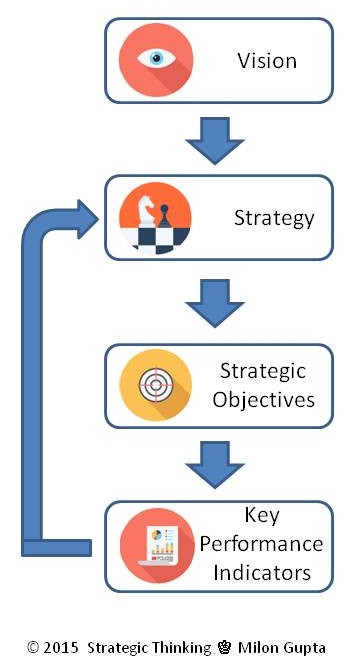Key performance indicators (KPIs) have become commonplace in large and medium-sized companies worldwide. However, despite the widespread use of KPIs, many companies still have not managed to get a high benefit from KPIs. Frequently, KPIs are just seen as a tool for measuring performance on an operational level. This approach misses the benefits KPIs can offer for strategic planning and strategy implementation.
The role of key performance indicators in strategic planning

Key performance indicators can be an essential success factor for strategy implementation. In the strategic planning process, KPIs can be directly linked to the achievement of strategic objectives (see figure).
A company’s strategy is the way in which it endeavors to realize its vision in the mid- to long-term. In order to reach the envisioned state, the strategy needs to be translated into action via strategic objectives. They can be further broken down into operational objectives. The achievement of both strategic and operational objectives needs to be regularly monitored in order to see, if the corporate strategy is on track.
This is where KPIs come in. They provide evidence on the degree to which strategic and operational objectives have been achieved. In this way, KPIs serve as an early-warning system for strategic and operational problems. If deviation between the measured performance and the targeted performance is at a significant level, it is time to reconsider, analyze the causes, and take action.
While this may sound straightforward, implementing KPIs in practice entails a number of challenges, and quite often, KPIs are not used in the most effective way.
Five common mistakes in using KPIs
1. KPIs are not aligned with strategic objectives
The crucial word in ‘key performance indicators’ is ‘key’. You can collect data for numerous performance indicators. However, in order to get the data that you need for making the right strategic decisions, you first need to decide, which performance indicators are key.
The criterion for branding a performance indicator as key is, how much it is aligned with a strategic objective. Let us assume you are a start-up company with the strategic objective of increasing the number of customers within the next year to 1,000. Then, a KPI called ‘Number of newly acquired customers’ would be aligned with this strategic objective. A KPI named ‘Level of financial reserves’ would not be aligned with this objective. It might even be opposed to the objective, as achieving it may require investments in marketing campaigns that could undermine the financial reserve.
2. Selection of KPIs is limited to those easily measurable
It is very tempting to limit yourself to KPIs that are easy to measure, like, for example, capital expenditure. However, depending on your strategic objectives, this may be insufficient. As Albert Einstein once said: “Not everything that can be counted counts, and not everything that counts can be counted.”
If you are in the service business, ‘Customer satisfaction’ is very likely an important KPI. However, it is not really countable like capital expenditure. Nevertheless, it is possible to get an indication of the level of customer satisfaction, for example via a customer satisfaction survey.
It gets even more difficult, if you have a strategic objective of sustaining an innovation-friendly corporate culture. Although this is basically impossible to measure directly, you may find indicators for it, like, e.g., the number of new ideas for product features submitted by employees in a month.
3. Selection of KPIs gives too much weight to the past
There is a distinction between backward-oriented KPIs and forward-oriented KPIs. Both are important. However, if you have only backward-oriented KPIs, you create a strategic problem for your company. It is like only looking in the rear-view mirror while you are driving. Backward-looking KPIs are those that are focused on past results; sometimes they are also called key results indicators (KRIs). This could be, for example, turnover. It is important to know the turnover for the last quarter, but you have no chance of changing the result. A forward-looking KPI has influence on a future result and offers, thus, the opportunity to influence it through your decisions. This could be, for example, ‘Customer orientation’, which may help drive sales and turnover.
4. KPIs are used as instruments for controlling employees
The risk of some KPIs is that they can be used for controlling and even punishing employees. Take, for example, a KPI like ‘Number of sales per sales representative’. Although it may be interesting to know the data down to an individual sales rep level, you may provoke behavior that is counterproductive. If employees notice that their honestly produced data will be used against them, e.g., for reducing their bonus, it may stimulate counterproductive behavior, e.g. sales reps sell at loss-making discounts, in order to increase their number of sales.
5. No distinction between strategic and operational KPIs
There is a difference between strategic and operational KPIs, which is often neglected. Strategic KPIs are relevant for longer-term performance. Thus, gathering data for them is not as frequently required as for operational KPIs. For some operational KPIs, especially in production processes, data need to be captured and monitored almost in real-time, while for strategic KPIs a monthly or quarterly data gathering and monitoring frequency would be sufficient.
Three recommendations for using KPIs
Based on the insights above, I would like to give three recommendations for getting the best out of KPIs.
1. Closely align strategic KPIs with strategic objectives.
Keep strategic KPIs relevant to your strategy implementation and your regular strategy review, by making sure, they are relevant and closely linked to a specific strategic objective.
2. Integrate KPIs in a strategic management framework.
You can increase the effectiveness of KPIs by integrating them in a strategic management framework. One of the most popular frameworks is Balanced Scorecard. Despite some challenges in its practical implementation, I would still recommend to use it.
3. Apply stringent criteria for selecting your KPIs.
KPIs are like torchlights used to shine into different corners of your business. Due to limited resources, you cannot shine into every corner. Thus, you should make a stringent selection of KPIs based on criteria like relevance to your strategic objectives, balance between forward-looking and backward-looking KPIs, and comprehensibility of KPIs.
Conclusion
KPIs can make the difference between successful strategy implementation and failure to detect and adapt to strategic challenges early enough. The key is to implement strategic and operational KPIs in the right way, which means that they should be aligned with the corporate strategy and relevant to the purpose.
